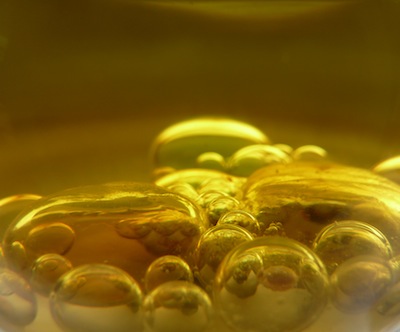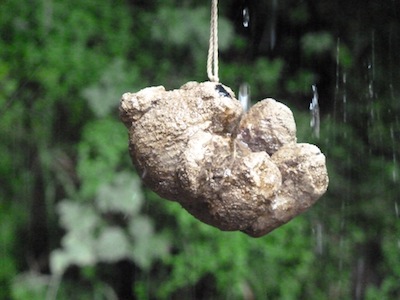We are happy to introduce you to Rachel Armstrong, Senior Lecturer in Research & Enterprise at the University of Greenwich and TED fellow since 2009, who will be speaking at Lift13 in the session "From science to fiction". Rachel was named as one of the top ten UK innovators by Director Magazine and featured in the top ten 'big ideas, 10 original thinkers' for BBC Focus Magazine. Learn more about her exceptional work in this short interview:
Who are you and what do you do?

I grew up with a passion to work with the creative potential of living systems and have never had to relinquish that childhood dream. My enthusiasm to tap into the incredible transformative powers of Nature has taken me down many different pathways and introduced me to a variety of careers including medicine, pharmaceutical communications and architectural research. I am currently combining the disciplines of chemistry and architecture to propose and demonstrate that we can design and engineer with the material world differently to the conventions of modernity. Our current view of matter is that it is dumb and needs our instruction before it can do useful things. This perspective is embodied in the way we imagine and make our machines. Of course, quantum physics has shown us that matter is very far from dull and so I have been working on ways of demonstrating how we might unleash the extraordinary potential of the material world so that we can innovate organically.
Tell us a bit about one of your latest projects you were working on.
I am project leader for the Icarus Interstellar group’s Persephone project – which is responsible for the design of a ‘living’ interior of a worldship. This is part of the DARPA funded 100YSS (One Hundred Year Starship) project being scheduled for completion in a hundred years and assembled in earth’s orbit. Persephone imagines the interior of the worldship as an ecology that literally grows an environment for space travellers from the bottom-up. Persephone takes the form of an international collaboration between designers, engineers and architects. It is currently at its earliest stages of development and is raising questions about the way we design and engineer such as, how do we work cross generations to achieve a common goal? How do we keep our engineering solutions ‘open’ so that they do not become obsolete but evolve with changing technology and the needs of people? Persephone also serves as a real innovation platform for collaborators to develop prototypes that may address some of the greatest current challenges in our proliferating megacities – which are vast urban expanses that house more than ten million people such as Beijing, New York and Sao Paolo – by re-thinking the way we inhabit space, make buildings, develop infrastructures, engage technologies and use our terrestrial resources.
What recent change, technological or social, were you surprised by?
 I was surprised – and delighted – by the number of new carbon capture and recycling technologies available. Although the most interesting ones such as, artificial photosynthesis and extracting ‘fuel’ from the air will not produce geoengineering scale effects, I was inspired just how fast our innovators could respond to new challenges when there was proper funding for them!
I was surprised – and delighted – by the number of new carbon capture and recycling technologies available. Although the most interesting ones such as, artificial photosynthesis and extracting ‘fuel’ from the air will not produce geoengineering scale effects, I was inspired just how fast our innovators could respond to new challenges when there was proper funding for them!
The carbon-fixing system that has been proposed for the smart droplet technology I work with, is very simple in comparison to some of these high tech carbon capture innovations. However, the principle it demonstrates – that our buildings can contribute to a more lively environment – rather than accepting that the best we can do with buildings is confer them with ‘neutrality’, is a very important one.
What do you do to deconnect?
I guess ‘deconnecting’ is the wrong word for me – 'reconnecting' is what I seek when I need to recharge my energy and imagination. I do this by visiting incredible natural sites that are laden with mythology. In that way I am similar to the titan Anateus whose strength came from his connection to his mother ‘earth’. There is nothing that I enjoy more than visiting extraordinary places that  have a deep ecological significance and tap into the strangeness of our world such as, The Jurassic Coast in Devon where Mary Anning uncovered the fossils of prehistoric creatures such as, the ichthyosaur - or, the ‘Petrifying Well’ at the Mother Shipton Cave where the ground is so rich in minerals that it turns soft objects that are hung in the water that trickles through, like teddy bears and hats, into stone. I aspire to visit the troglodyte Movile cave in southern Romania someday, which was only discovered in 1986 and has an extraordinary ecology that has evolved in the absence of light. This incredible place is close to the Black Sea where I was conducting some field research on a ‘Terminator’ algae a few years ago. This particular species can completely regenerate itself following complete mechanical destruction and I was trying to find out how to magnetise it - so I am certain that the ecology within this lightless cave will be absolutely extraordinary!
have a deep ecological significance and tap into the strangeness of our world such as, The Jurassic Coast in Devon where Mary Anning uncovered the fossils of prehistoric creatures such as, the ichthyosaur - or, the ‘Petrifying Well’ at the Mother Shipton Cave where the ground is so rich in minerals that it turns soft objects that are hung in the water that trickles through, like teddy bears and hats, into stone. I aspire to visit the troglodyte Movile cave in southern Romania someday, which was only discovered in 1986 and has an extraordinary ecology that has evolved in the absence of light. This incredible place is close to the Black Sea where I was conducting some field research on a ‘Terminator’ algae a few years ago. This particular species can completely regenerate itself following complete mechanical destruction and I was trying to find out how to magnetise it - so I am certain that the ecology within this lightless cave will be absolutely extraordinary!
--
At Lift13 Rachel will talk in the session "From Fiction to Design". Join participants from over 30 countries to get your innovation boost and get your Lift13 ticket!


 I was surprised – and delighted – by the number of new carbon capture and recycling technologies available. Although the most interesting ones such as, artificial photosynthesis and extracting ‘fuel’ from the air will not produce geoengineering scale effects, I was inspired just how fast our innovators could respond to new challenges when there was proper funding for them!
I was surprised – and delighted – by the number of new carbon capture and recycling technologies available. Although the most interesting ones such as, artificial photosynthesis and extracting ‘fuel’ from the air will not produce geoengineering scale effects, I was inspired just how fast our innovators could respond to new challenges when there was proper funding for them! have a deep ecological significance and tap into the strangeness of our world such as, The Jurassic Coast in Devon where Mary Anning uncovered the fossils of prehistoric creatures such as, the ichthyosaur - or, the ‘Petrifying Well’ at the Mother Shipton Cave where the ground is so rich in minerals that it turns soft objects that are hung in the water that trickles through, like teddy bears and hats, into stone. I aspire to visit the troglodyte Movile cave in southern Romania someday, which was only discovered in 1986 and has an extraordinary ecology that has evolved in the absence of light. This incredible place is close to the Black Sea where I was conducting some field research on a ‘Terminator’ algae a few years ago. This particular species can completely regenerate itself following complete mechanical destruction and I was trying to find out how to magnetise it - so I am certain that the ecology within this lightless cave will be absolutely extraordinary!
have a deep ecological significance and tap into the strangeness of our world such as, The Jurassic Coast in Devon where Mary Anning uncovered the fossils of prehistoric creatures such as, the ichthyosaur - or, the ‘Petrifying Well’ at the Mother Shipton Cave where the ground is so rich in minerals that it turns soft objects that are hung in the water that trickles through, like teddy bears and hats, into stone. I aspire to visit the troglodyte Movile cave in southern Romania someday, which was only discovered in 1986 and has an extraordinary ecology that has evolved in the absence of light. This incredible place is close to the Black Sea where I was conducting some field research on a ‘Terminator’ algae a few years ago. This particular species can completely regenerate itself following complete mechanical destruction and I was trying to find out how to magnetise it - so I am certain that the ecology within this lightless cave will be absolutely extraordinary!